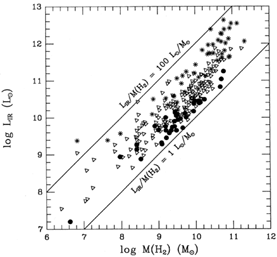Copyright © 1991 by Annual Reviews. All rights reserved
| Annu. Rev. Astron. Astrophys. 1991. 29:
581-625 Copyright © 1991 by Annual Reviews. All rights reserved |
6.5 CO-IR Luminosity Correlation
A large number of CO-IR comparisons have been reported in the literature (Rickard & Harvey 1983, Young et al 1984, Sanders & Mirabel 1985, Young et al 1986a, b, Sanders et al 1986, 1987, Tacconi & Young 1987, Solomon & Sage 1988, Kenney & Young 1988b, Young et al 1989, Tinney et al 1990, Sanders et al 1991). These correlations exhibit at least an order of magnitude of scatter, which is much more than that expected on the basis of measurement uncertainties.
Figure 7 shows a plot of the infrared (IR) and
CO luminosities for
more than 200 galaxies from several studies. The CO luminosities were
derived as described in
Kenney & Young (1988a),
whereas the infrared
luminosities are based on coadded IRAS data and computed following the
method of
Lonsdale et al (1985).
The values of the ratio
LIR / M (H2)
range from 2 to 200 L M
M -1 with
the higher values occurring in
interacting and merging galaxies (see
Sections 8-9 and
Figure 11) and
in starburst irregular galaxies. In
Figure 7, where the galaxies are
coded by dust temperature, it is clear that the ratio
LIR / M (H2) is
closely correlated with dust temperature. Such a separation by dust
temperature is not found for the comparison of IR luminosities and HI
masses in the IR bright galaxies, thereby strongly suggesting that the
dust emission in these galaxies is more closely tied to the molecular
than to the atomic gas content. The correlation of the
Td with the
ratio LIR / M (H2) can be
understood, since a higher radiation energy
density (i.e. L/M) leads to a higher radiative equilibrium dust temperature.
-1 with
the higher values occurring in
interacting and merging galaxies (see
Sections 8-9 and
Figure 11) and
in starburst irregular galaxies. In
Figure 7, where the galaxies are
coded by dust temperature, it is clear that the ratio
LIR / M (H2) is
closely correlated with dust temperature. Such a separation by dust
temperature is not found for the comparison of IR luminosities and HI
masses in the IR bright galaxies, thereby strongly suggesting that the
dust emission in these galaxies is more closely tied to the molecular
than to the atomic gas content. The correlation of the
Td with the
ratio LIR / M (H2) can be
understood, since a higher radiation energy
density (i.e. L/M) leads to a higher radiative equilibrium dust temperature.

|
Figure 7. Comparison of total H2 masses
and IR luminosities for galaxies from several studies
(Stark 1979,
Young et al 1986a,
Sanders et al 1986,
Tacconi & Young 1987,
Solomon & Sage 1988,
Kenney & Young 1988a,
Young et al 1989,
Thronson et al 1989a,
Tinney et al 1990,
Sanders et al 1991).
The H2 measurements included consist of major
axis maps for galaxies larger than 3', and single observations for the
smaller galaxies. Points are coded by dust temperature, with
stars for
Tdust > 40K; triangles for
Tdust between 30 and 40K; and
circles for
Tdust < 30K. The diagonal lines shown
represent LIR / M (H2) = 1 and 100
L |